A Fragment of the Past: The System of Hotel Front Office Racks
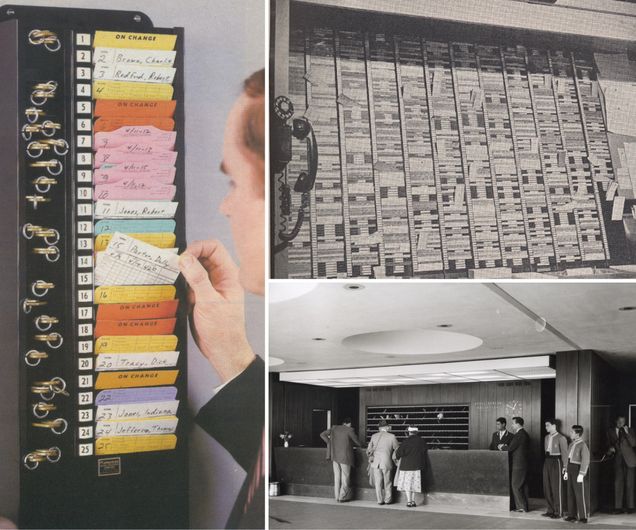
By Peter Szende and Pooja Reddy
Front-of-House & Front Desk
Have you ever really noticed the front desks of the hotels that you visit? Chances are, you don’t think twice about it—because more and more, the front-of-house area is designed to be subtle and unobtrusive. If you are aware of the front desk area, it’s more likely to be due to its high-tech accoutrements and services. Some hotels now come equipped with features like automated check-in kiosks and even computerized luggage carriers. While this may not be the standard, it’s rapidly becoming more common and indicates the direction that hotels are taking for their front-of-house environments. Since the front desk is usually the first point of contact that guests have with a hotel and is where they check in and out, request information, settle their accounts, and offer different types of feedback (Steadmon & Kasavana, 1988), the accessibility and style of this area can make a huge impact.
Prior to the introduction of computerization and other technological updates, front office tasks were performed quite differently, although the front desk was just as integral and the system was extremely orderly and efficient. The evolution of the hotel front-of-house, as overseen by the front office department, over the last several decades indicates larger changes and trends within the hospitality industry itself. This article takes a trip back in time and offers a glimpse of the past through an exploration of the old systems of hotel front office racks.
Let’s first go back to the early 20th century: during this time, hotels were considered to be “manual,” and most functions were carried out by systems that leveraged heavily on human capital. Besides billing and accounting, the hotel staff were responsible for duties like room status checks and guest registration. As advancing technology began to address some of these functions, hotels gradually transitioned to the use of “electromechanical systems which were semi- automated, before moving to a wholly computerized, fully automated arrangement” (Steadmon & Kasavana, 1988). The heart of the front desk became a metal file system that consisted of pockets to hold rooming and reservations slips, called the room rack. You may already be familiar with the room rack without knowing: it is from this system that we have derived the term “rack rate,” the undiscounted price a hotel will charge for a room. Formerly, when guests arrived at a hotel without a reservation, “traditionally, the standard rate was posted on or near the room rack.” (Steadmon & Kasavana, 1988, p. 110).
![John Willy Room Rack [Advertisement] (1920, July). The Hotel Monthly, 28(328) p. 11.](/bhr/files/2017/05/imae-1-526x636.png)
The pneumatic tube was also a system used in earlier hotels. Behind the clerk’s desk, where the mail and information racks were located, a battery of pneumatic tubes connected to every department of the hotel. These extensively utilitarian tubes carried a mass of information ranging from mails and orders to charges and meal checks. These tubes saved a lot of time and labor and accelerated several procedures by creating a network between service departments (Willy, 1919). Even as recently as the 1980s, you could send restaurants checks through this pressurized air network directly to the hotel’s front office cashier. In just a few seconds, the check traveled through the pneumatic tube to the bill clerk, who would quickly post the charges before the guest checked out.
Key Front Office Positions in a Manual Hotel
Today, it would be almost impossible to maintain a room rack or pneumatic tube system because the sheer size and breakdown of contemporary hotels render it completely impracticable. However, hotels in the past were smaller and contained fewer major departments. For example, the New Yorker Hotel’s front office consisted of three departments: the reservations department, the mail and information department, and the rooms department. Using the New Yorker Hotel as of 1931 as an example, we can trace the history and development of these departments and the positions within them.
Reservations Department
Reservation clerk: The reservation clerks answered reservation telephones and filed reservation slips or tabs in the room rack. The slips or tabs were usually color-coded to denote the type of reservations. Below is an example of a color code system (Dukas, 1960, pp. 24-25).
Regular Reservation |
Late Arrival |
Special Attention |
Conventions |
Travel Agency |
Reservation |
In more advanced reservation systems, hotel reservationists completed carbonated, perforated rack slips on a typewriter, after which copies were distributed to various areas of the front office and hotel as needed.
Mail and Information Department
Mail and information clerk: Like the reservation clerks, the mail clerks answered telephones and inquiries specific to their department’s purview. They also made verifications of “unregistered” reports which are given out by switchboard operators. The mail clerk checked emergency arrival slips and accepted incoming telegrams and special delivery letters. He/she also handed out keys and mail to guests.
Tube clerk: The tube clerks were in charge of receiving and dispatching mail to and from the different floors and departments through the pneumatic tube system.
Rooms department:
Room clerk: Room clerks were stationed at the registration desk to serve the guests. The room clerk had to be knowledgeable about the different types of rooms in the hotels, along with their respective amenities, furniture, and location. The room clerk instantly knew how to handle each arrival, as the color of the slips the guest carried or received indicated the type of booking (Ducas, 1960).
Rack clerk: Rack clerks were in charge of checking the status and condition of the rack at any point of time, as well as at specific hours against vacancy reports, and made any necessary corrections.
Stacks of Racks: the Different Types of Racks
The room rack is only the tip of the iceberg: hotels adopted a rack system for just about every facet of their front desk operations. Not only did they each serve different purposes, but the various structures also reflected different styles and systems in vogue at the time. It may be hard to imagine what they might have looked like; so, since a picture is worth a thousand words, we have compiled a quick photo gallery to create a visual guide to the past.
Reservation Rack
The reservation racks contained the names of the expected guests and their arrival dates. Typically, there was one rack for every day of the upcoming months and fewer racks for future arrival dates. In larger hotels, racks often covered the whole wall of the reservation office.
![Dumont [Advertisement] (1917, April). Office Appliances, XXV(4) p. 26.](/bhr/files/2017/05/Image-2.png)
Room Rack
According to Ismail (2002, p. 200), “The room rack would identify each room type and configuration at a glance,” as well as the occupancies and vacancies available in the hotel (Dukas, 1960, p. 37). Managers would mark each room on the rack according to a certain color code in order to note the room status. The unique code would provide information regarding the occupancy, cleanliness, and pricing of that particular room. The room rack not only indicated the type and location of the room, but also details like the room’s occupancy status, its rate for single and double occupancy, and its connections to abutting rooms (Dukas, 1960).
Much like today’s front desk set-ups, room racks were designed to be nearly invisible upon check-in. Sophisticated systems were typically mounted and arranged in a 60-degree angle behind the front desk. A typical room rack is shown in the picture below.
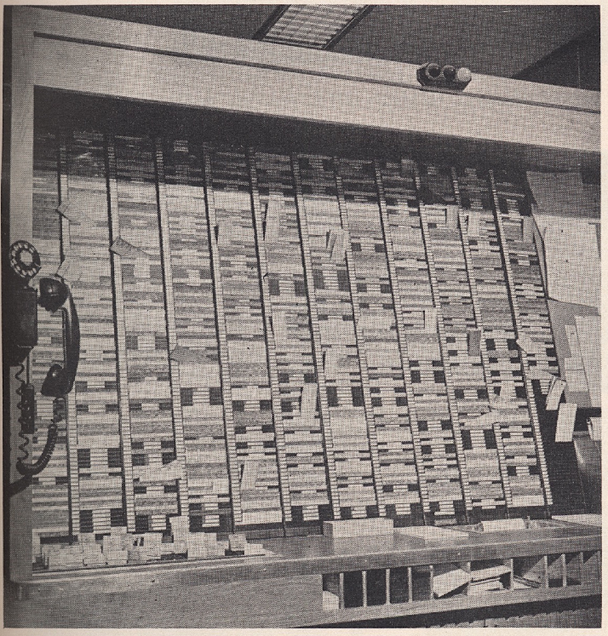
This is how the ‘The Hotel World Magazine’ described the job of room clerks upon visiting a hotel in New York City:

As with any object feature, time and innovation gradually caused the room rack to evolve. Frederick A. Muschenheim, the brother of the owner of the Astor Hotel in New York, made several innovations in hotel technology (Miscellaneous Hotel Notes, 1913, p. 66)., one of which was a room rack frame with flexible card holders mounted on pivots.
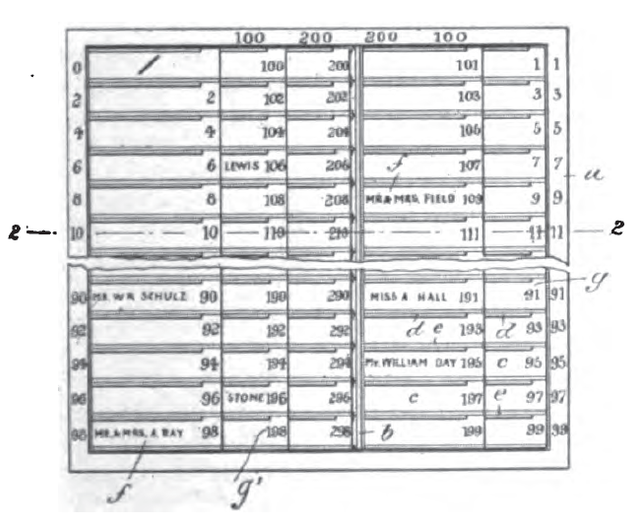
Sales Rack
To avoid selling the same room twice and to facilitate the sales of rooms, busy hotels used a control rack that consisted of the cards of every room in the hotel that was available for sale.
Room Sales Rack with Price Zones and Markers

Letter and Key Rack
The letter and key racks contained pigeon holes for the aforementioned items. They maintained guest keys and were arranged by room number.
Letter and Key Rack at the Hilton Istanbul
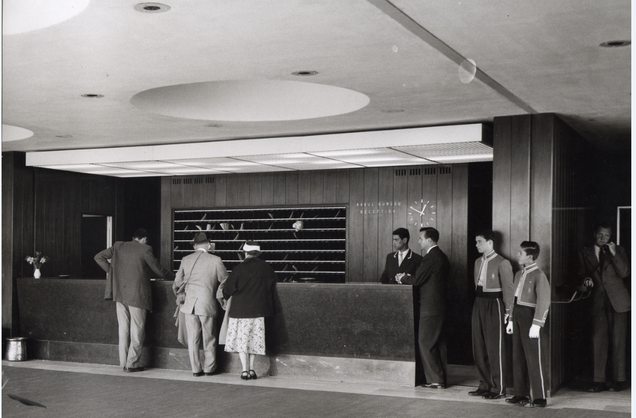
Key racks were sometimes combined with the room rack in order to minimize the number of racks. Below is an example:
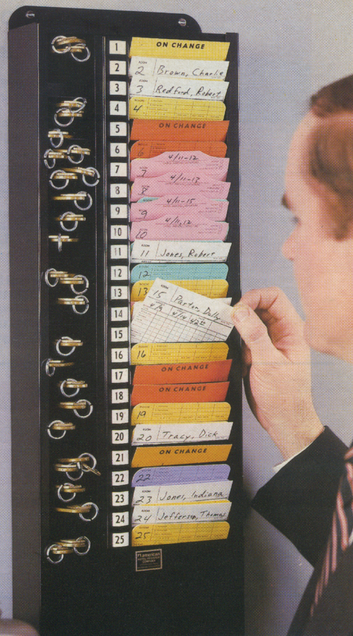
Information Rack
These racks contained the names and room numbers of all the registered guests of the hotel. The racks were alphabetically organized by the guests last name.
A Rotary Type Information Rack
![Source: Kohler [Advertisement] (1921, July 2.) The Hotel World: The Hotel and Travelers Journal, 93(1), p. 59.](/bhr/files/2017/05/image-10.png)
Room Racks with Electric Signaling Devices – Early Efforts
In order to facilitate instant communication between the room clerks and the housekeeping department, the Astor Hotel in New York introduced an electrical system with lights in the early 20th century. The system is said to have consisted of a set of sockets for small electric bulbs which were positioned at the front of the room rack. The system was directly linked to bulbs on the doors of every room. When the room clerks received notice from the cashiers that a guest had vacated the room, they would place a bulb into the corresponding room number on the rack. The bulb would light up, and the light on the room door would immediately flash up and down at regular intervals. This brought the attention of the housekeeping staff, who inserted a key below the bulb on the door when he or she went in to make up the room. This would then turn off both the light on the door and the light on the room rack as well. The automatic signal device saved a considerable amount of time and labor (Efficiency at Astor, p. 26).
Room Racks with Electric Signaling Devices – Efforts at the Advent of Computerization
In the 1970s, leading hotel chains of the time, such as Hilton and InterContinental, significantly enriched their hotel signaling systems. Following in the footsteps of Muschenheim, room racks evolved to be complemented by consoles that indicated room status and housekeeping requirements. Toward the end of the 1980’s, computerized systems based on a combination of lights enhanced front office operations by indicating the exact room status next to each room rack slip. Housekeeping employees could change the status of the room rack remotely by turning their keys in a socket located in the guest rooms.
Room Status Light Combinations on the Room rack at the Forum Hotel Budapest in the 1980s. (Courtesy of Péter Várhegyi)
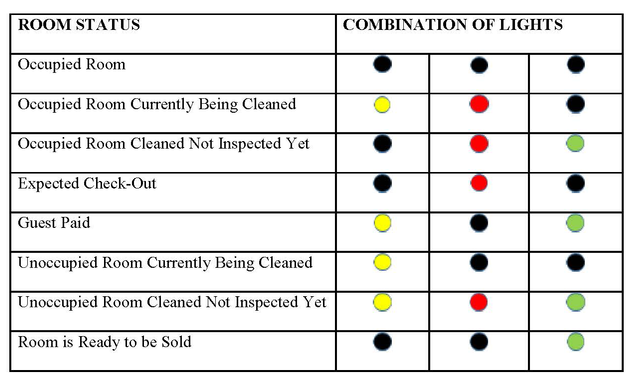
In automated systems, most of the racks discussed above were eliminated, as information is internally managed by the computer systems. Today, it is rare to find any hotel operating on a rack system; letter and key racks occasionally still exist to preserve a memento of the past.

Dr. Peter Szende has over 25 years of management experience in the hospitality industry in both Europe and North America. He joined the Boston University School of Hospitality Administration as an Assistant Professor in 2003. He was promoted to Associate Professor of the Practice in 2010. Currently, he serves as Associate Dean of Academic Affairs.
Pooja Reddy is a senior at Boston University, pursuing a Bachelor of Science in Hospitality Administration and a double minor in Business and Deaf Studies. She currently works as a student office assistant at the School of Hospitality Administration, and a marketing intern for Tasting Counter, Somerville.
References
-
Willy, J. (1919). Hotel Pennsylvania of New York. The Hotel Monthly, 27(321), p. 28.
-
Efficiency at Astor. (1917, September 15). Hotel World, LXXXV(11), p. 26.
-
Ismail, A. (2002). Front Office: Operations and Management. Albany, NY: Delmar
-
Dukas, P. (1960). Hotel Front Office Management and Operation. Dubuque, IA: WM.C. Brown.
-
New Yorker Hotel (1931). Front Office Manual.
-
Steadmon, C., & Kasavana, M. (1988). Managing Front Office Operations. East Lansing, MI: AH&MA.
-
Miscellaneous Hotel Notes (1913, May). The Hotel Monthly, 21(242) p. 66.
22 comments
Thanks a lot. Very useful information of the past transitioning to current practices.
Great article.
I started in the Hospitality business back in the 1960s then moved on to computer programming. from time to time I returned the front clerking more for the fun of it than the money.
We didn’t have computers then (except Holiidex) but something that I REALLY miss is the room rack.
If I ran a fd today, I’d demand a rack. You need a place to store paperwork anyway (reg card, etc) so why not a room rack?
Organized properly, one can immediately identify availability, occupancy, & room status. Even if there’s a complete loss of power, the only thing you need is a flashligjt to run the desk.
What the property management system is great, the new technology I really appreciate is the key cards. And as a one-time Night Auditor today (I only Clerk on the 3 to 11 shift) I don’t miss posting room and tax on every folio one damn bit.
I agree on the board. We still use them here and in fact, I need more of these cards. I can’t find a place that sells them. Perhaps I’ll just mock some up myself.
Beautiful post author. Thank you. Keep it up.
Excelent post! Thank you.
any idea where we can purchase the metal reservation rack? We still use them. Thank you,
Lorraine
Ever heard of the Canton Account Register? Made by Thomas Register in Canton Ohio
When do you think the hotel service sector began?
Thank you for this article I realize the evolution in terms of Hotels Facilities.
Thank you for this article I realize the evolution in terms of Hotels Facilities.
Fascinating to see how this worked in the past. I worked in the hospitality industry for 15 years, and while I no longer do, was curious and surveyed 50+ hotel brand leaders what they thought about the role of the property management system in their operations today and how it supports the front-of-house. Turns out it’s still the most important technology they use – but they want it to integrate with other point solutions. It seems we’re seeing an increased need for tech to support staff as the industry deals with labor challenges – and hopefully business returning quickly to pre-pandemic levels.
The old hotels had a button in each room that guests use to summon service from the front desk. Pushing the button caused N arrow to point to the room that wanted service. What was the wall box that held the arrows called? I have one from a 1904 hotel. Box made by Moon manufacturing
Thanks For Sharing The Very Interesting Article Very Helpful. Also, Visit:- Magento 2 Checkout Custom Fields Extension
The System of Hotel Front Office Racks is crucial for efficient hotel management. It’s like the backbone of a smooth guest experience. If you’re interested in diving deeper into this topic, you might want to check out https://writemyassignmentforme.uk/answers/describe-how-duty-of-care-relates-to-the-duty-of-candour.php for some valuable insights and additional information.”
NICE POST! keep posting it Thank you Visit for more: https://assignmenthelpae.ae/coursework-writing
penawar sakit lutut episor gambir
ubat sakit lutut episor harga
ubat sakit lutut jus tigas
ubat sakit lutut jus tigas original
ubat sakit lutut jus tigas testimoni
This is an awesome and helpful article for me. I will appreciate if you write a article about manufacturers for interior furniture.
Este es uno de los post más importantes. Gracias por compartir chicas escort San Miguel un contenido tan único con todos.